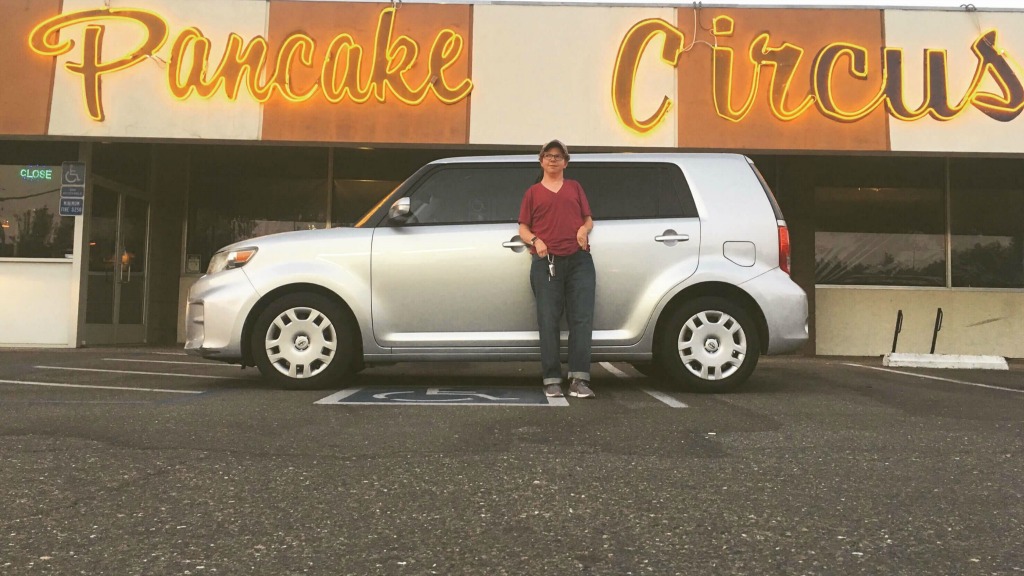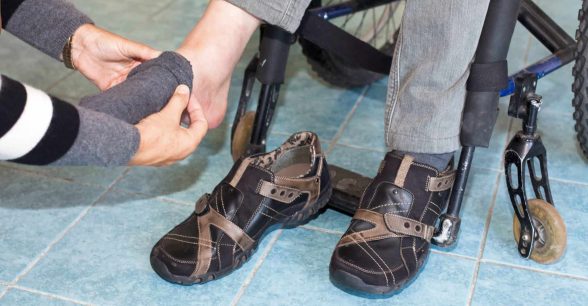What Transportation Access Really Means for Disabled People
The strange man at the gas station in Utah approached shyly. I was alone, several hundred miles from home. It was one of those anonymous pit stops between where you’re from and anywhere else that sees a ceaseless tide of bleary eyed travelers, lost in thought, filling their vehicles with fuel and their stomachs with junk food and strong coffee. Tank refilled, I had just lowered myself into the driver’s seat and begun the awkward-looking seated twist I do when my joints have stiffened into place and not yet decided to fully loosen. “Let me help you,” the strange man said, stepping towards the halfway opened driver’s side door of my car, an out of place Scion with California plates very deep in Jeep country. His hand was already on the door handle.
Obviously, I can get myself situated in my own car. But I have never quite been able to fault strangers for kind curiosity, especially in such in-between places. I have to wonder, though – how did the strange gas station man think I had gotten here? Did he imagine some evil non-disabled person back in California shoving me in this car with a nefarious cackle and telling me to head east? This story was too interesting not to play along with. So I swung my body the rest of the way into the seat and laid it on too thick with a “Gee, thanks, mister!” out the opened window.
My car is the best mobility device I have ever used. The distance I can walk shifts from day to day, anywhere from a few steps to a half mile. The ability to hop in my car and get wherever I need or want to go is an unparalleled thrill that has filled my life with opportunities and adventures that would not be otherwise possible. It took three years and way too much rigmarole to recount to get my driver’s license. My car is modified; it has a gigantic rear-view mirror and a fairly expensive modification to make the steering wheel easier to turn. The expense and the hassle were nothing compared with the freedom and ease they have allowed me. But funds needed to adapt a car and the means to pass a driving test are not at all guaranteed for disabled people. Without an adapted car, you must rely on the goodwill and free time of friends or on public transportation for anything that involves leaving your house.
Access to public transportation has been a protected right of disabled people for over 40 years. Both the Rehabilitation Act of 1973 and the Americans with Disabilities Act of 1990 provide protection for disabled people who want to use public transportation. In 1978 in Denver, 19 disabled people known as the “Gang of 19” blocked busses in their city to demand their basic right to use public transportation be met. But in 2019, we are still fighting to make accessible transportation a reality.
Disabled people in urban areas have stories of being left waiting for paratransit, of the appointments they miss and the opportunities they lose out on. Stories of accessible busses passing them by or stopping too far from the sidewalk to enter. Stories of impassible sidewalks and narrowly-avoided catastrophes when drivers fail to see us.
For disabled people in rural areas, the distances that must be traveled are greater and there are fewer accessible transportation options, if any. Paratransit must be offered only within 3/4 of a mile of a bus line and most rural roads don’t have sidewalks. This effectively leaves many of us stranded in our homes or risking our lives on narrow, generally high-speed roads.
Lack of access to the mobility that non-disabled people take for granted puts disabled people at risk and shuts us out of opportunities. You cannot find friends at events you can’t attend any more than you can hold a job that you can’t get to, or take care of your health at a hospital that may as well be on Mars.
Transportation is freedom. Yes, my trips into the wide-open spaces of the West can be characterized as frivolous, but like everything else, frivolity is not just for the non-disabled. This is my world and I intend to enjoy as much of it as possible. However, adventures aside, access to the reliable, accessible transportation that is my modified car – a toaster-oven looking wagon – is how I get to work each day, get to medical appointments, and keep up with the friends who give my life meaning. Without my car, given my disability, my world would be much, much smaller. I want to live in a world where disabled people have the freedom to live whatever sized life they choose regardless of their bank accounts or capacity to pass a test at the DMV.
About Rooted In Rights
Rooted in Rights exists to amplify the perspectives of the disability community. Blog posts and storyteller videos that we publish and content we re-share on social media do not necessarily reflect the opinions or values of Rooted in Rights nor indicate an endorsement of a program or service by Rooted in Rights. We respect and aim to reflect the diversity of opinions and experiences of the disability community. Rooted in Rights seeks to highlight discussions, not direct them. Learn more about Rooted In Rights




Paratransit transportation in my area has helped me get to medical appointments and back and forth to a job independently when family isn’t available. It wasn’t always available in my county…but it’s available now and I hope it never becomes unavailable again.
I wasn’t able to drive until I was 23 years old. My parents refused to let me drive their cars or even bother to teach me to drive because of the after affects of polio. After graduating from college with a degree in Accounting I used a bus for transportation until I saved enough money to make a down payment on my very first car. It was a red 1966 Chevrolet with a 327 engine. It was fast and spelled freedom – freedom as I’d never known before. It enabled me to visit friends, find my own apartment, change jobs, etc. I thought I could never live without a car again. A couple of cars later, it took me to Colorado where I fell in love with the mountains. My little 1200cc Mazda was not up to the adventures I wanted to go on so I bought a Toyota pickup truck. It took me into the back woods on logging trails – many of which were limited to 4-wheel drive vehicles. I challenged them in my little truck anyway. One time I got stuck in loose gravel and spent the rest of the day jacking up the truck and pushing it off the jack enough times to get the drive wheel out of the gravel and then to proceed back up the hill. I became a little more cautious where I took my adventures after that experience. As years went by and post-polio syndrome raised its head, I began using a power wheelchair which required the use of a lift equipped van – twice the size of my little pickup. My little Toyota was easy and fun to drive. It had plenty of power, was easy to park and had great visibility. The big old van was just the opposite in all those characteristics. It still spelled freedom – though limited – but was not fun to drive. Eventually, my disability progressed to the point I no longer felt safe driving on my own. I had to depend on others to drive me – usually at their convenience, not mine. When license plate and insurance bills arrived at the same time I realized that would buy a lot of Access-A-Ride tickets. It’s true that the days of Sunday drives through mountains are over but I moved to an apartment on a major light rail / bus route location that makes it easy to get around in Denver, one of the more accessible cities in the nation. I’m learning to adapt to a new experience that I’ve never done before – growing old.